Viltrox AF 56mm F1.7 X-Mount Review
Dustin Abbott
April 9th, 2024

I am extremely excited about Viltrox’s move towards premium lenses, like their upcoming LAB series and existing PRO lineup, but Viltrox is too clever a company to get locked into just one end of the market. Perhaps equally important to their development of higher end lenses is their development plans on the other end of the spectrum, where they are leveraging their growing optical expertise into high performing budget lenses. Ironically Viltrox has, from the beginning, built fairly premium feeling lenses. They have always been made primarily from metal, which feel nice but adds a bit of weight. So for Viltrox the transition to using plastic as the material for these new series of lenses was an intentional one.
The series began with the very useful AF 20mm F2.8 full frame lens (which I reviewed here), an extremely light, extremely inexpensive, but surprisingly strong optical instrument. They have announced a similar 40mm F2.5 STM full frame lens that is yet to come, but in the meantime their next lens in this series is the Viltrox AF 56mm F1.7 STM lens being released for Fujifilm X-mount. Fuji’s new XF 56mm F1.2 WR is a gorgeous lens, but it retails for a $1000 USD. This Viltrox lens will retail for under $150 USD (buy from Viltrox and use the code DUSTINABBOTT to get 8% more off!), meaning that you could buy nearly 7 of these lenses for the price of the Fuji. That makes it an attractive option for those who want this focal length but have a tight budget. Is it worth checking out? Find out my thoughts by watching the video review below…or just keep reading.
Follow Me @ YouTube | Patreon | Instagram | Facebook | DA Merchandise | Flickr | 500px
Thanks to Viltrox for sending me a review loaner of this lens. As always, this is a completely independent review. *The tests and most of the photos that I share as a part of my review cycle have been done with the Sony a7RV along with the Sony Alpha 1 that serve as my benchmark cameras for Sony lenses along with the Sony a7C2 that I happened to be reviewing at the same time.
__________________________________________________________________________________________________
Viltrox already has an existing autofocusing 56mm F1.4 APS-C lens (my review here) that they released in 2020, but that lens is heavier (290g) and more expensive ($299 USD) relative to this new lens. The Viltrox AF 56mm F1.7 has a slightly slower aperture (one half stop), lacks an aperture ring, but compensates in part by being extremely sharp. In fact, if you look at this chart I’ve made comparing the MTF from the two lenses, you can see that I’ve put a line through the 80% level. None of the performance of the older lens (at least at 30LPmm) reaches that threshold, while there is only the tiniest part of the image of the new lens that fall below that.
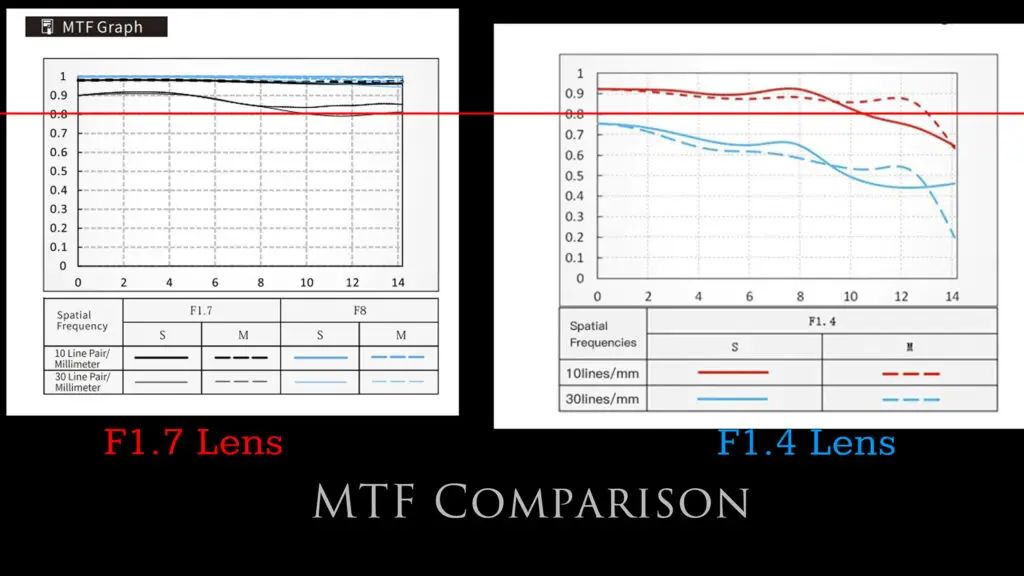
There is 15% more image sharpness in the center of the frame and and more than 20% more in the midframe. The corners are more like 40% sharper! This is going to be a very sweet bargain portrait lens. 56mm on Fuji’s 1.5x crop APS-C sensor translates to 84mm, a prime portrait focal length.

This tells us all we need to know about who this new lens is for: much like Samyang’s “Tiny series”, this lens is for those who don’t care about bells and whistles and just want a lightweight, high performing lens. And this lens is incredibly compact – look how compact it is when compared to the Fuji XF 56mm F1.2 WR and the yet-to-be-released TTArtisan AF 56mm F1.8 (another impressive little lens!)
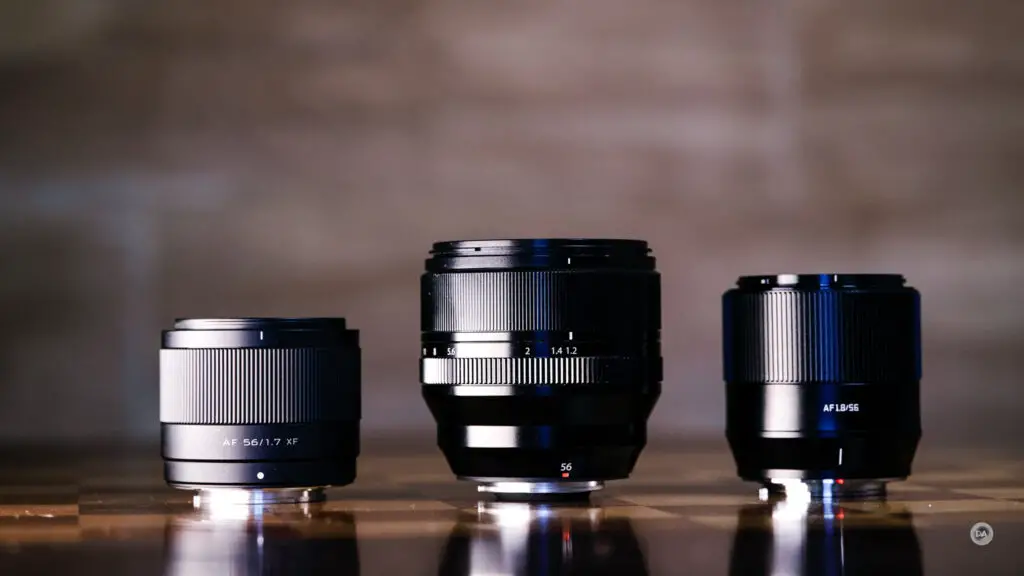
The Viltrox is going to need all of that sharpness for this test, as they are first releasing this lens on Fuji X-mount, which means that I’ll be reviewing it on the most demanding platform I currently test, Fuji’s 40MP X-Trans APS-C sensor in the Fujifilm X-H2. Is this the rare budget lens that can handle this sensor? We’ll find out together.
Viltrox AF 56mm F1.7 Build and Handling
The first thing to note is the slightly unusual maximum aperture value. Similar lenses are going to be F1.8, not F1.7, but I like this move as it sets the lens apart and gives it a small but real advantage over F1.8 lenses. F1.8 is 2/3rds of a stop slower than F1.4, while F1.7 is 1/2 half stop slower. When swapping between this F1.7 lens and another lens with a maximum aperture of F1.8, I found that the Viltrox produced a 1/35th second shutter speed vs 1/30th second for the F1.8 lens. That’s not a lot of extra light gathering but it is something.

As noted, the Viltrox AF 56mm F1.7 eschews the heavier metal casing typically used for Viltrox lenses and embraces a more conventional, lightweight design in polycarbonates (engineered plastics). I wouldn’t call the build high grade here, but what I can say is that nothing about the plastics feel flimsy. It doesn’t have the feel of the early Samyang Tiny series lenses but instead feels tough and durable; its the kind of lens that feels like it could survive some falls (not that I intentionally dropped it!)
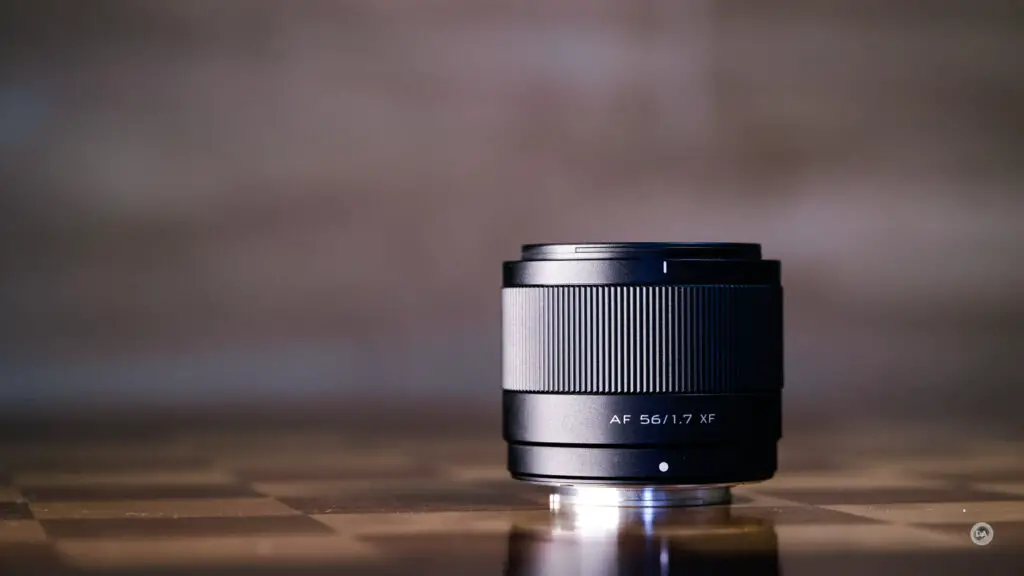
The new AF 56mm F1.7 is extremely compact, only 65mm in diameter (2.6″) and 54.7mm in length (2.15″). It weighs only 171g (6oz). You can see that while far from being a pancake lens, this lens only extends out a little way mounted on the camera.

This is a lens that is small enough to match even the smallest of Fuji’s cameras.
Up front we have a 52mm filter thread, which is a small but relatively common filter size. The front of the lens fascia has a variety of information imprinted on it and has a classic profile. I’m a fan of having some lens information on the front fascia, as I feel it adds character to the lens.
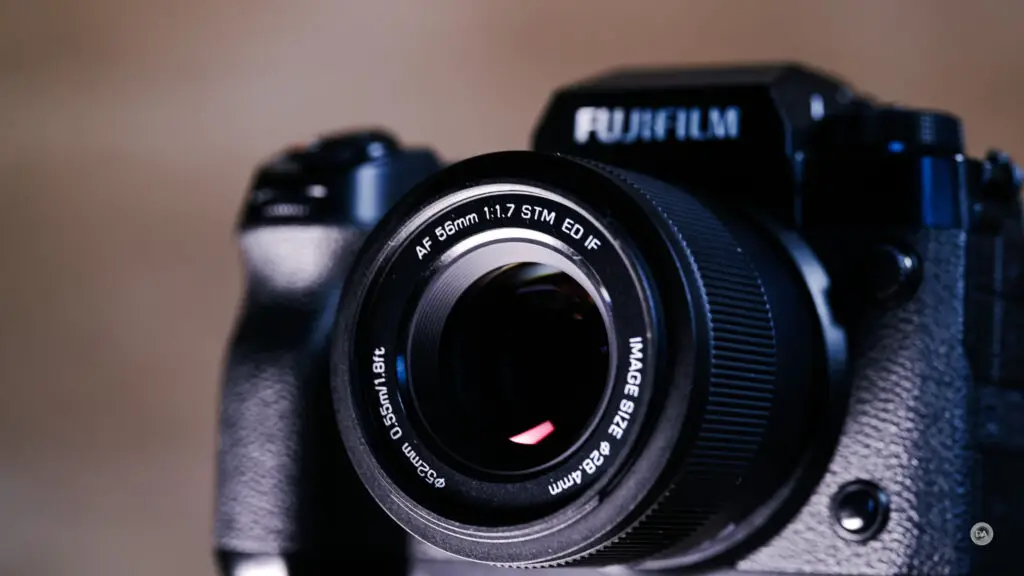
There is a very slim lens hood included that bayonets into place but without as much precision and confidence as I would like. It doesn’t feel like it really “clicks” into place and locks particularly well. A lens pouch is also included. The pouch doesn’t add a lot of protection value, but, like the hood, at least it is included. There are many more expensive lenses that include neither a pouch or a hood.
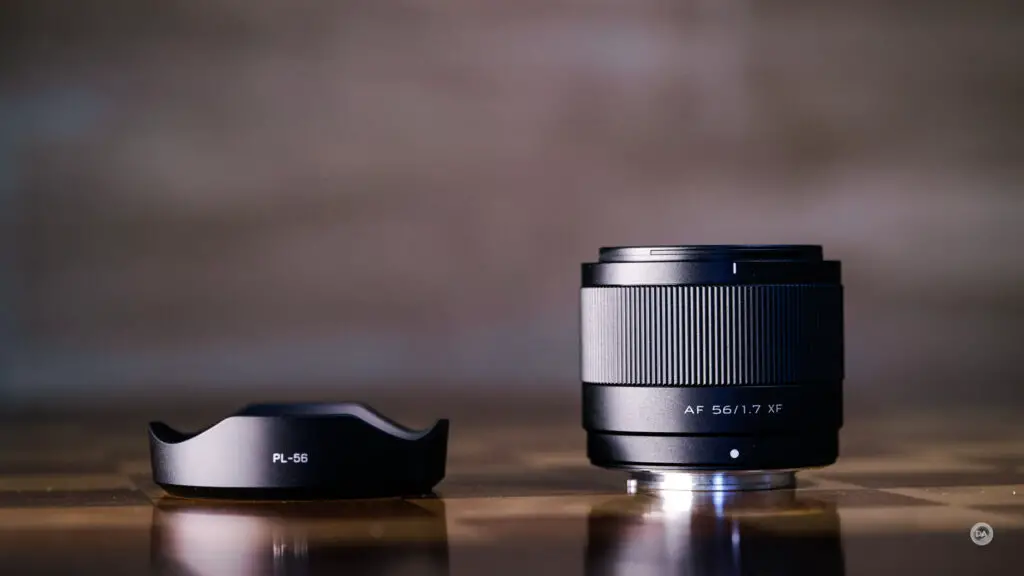
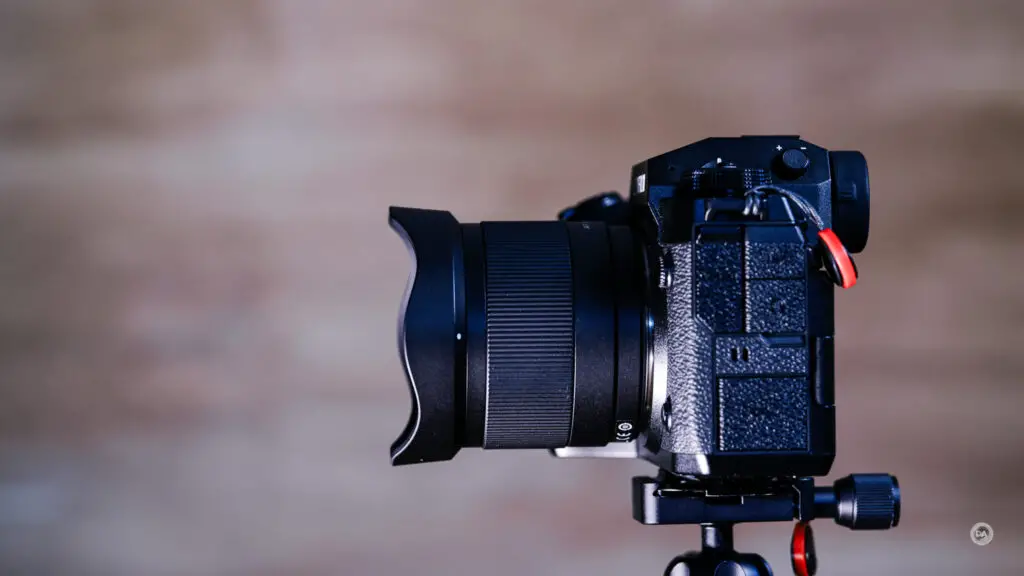
This inexpensive series is set apart from most of Viltrox’s lenses in that there is no aperture ring in the design. There are no switches, either. The only feature on the lens barrel is a wide manual focus ring. The manual focus ring has a nice amount of damping and moves smoothly. All manual focus aids (including automatic magnification of the focus area) will work with the Viltrox, though, as per usual on Fuji, major focus changes will take a lot of rotations, so manual focus is better reserved for fine tuning.

The Viltrox AF 56mm has 9 blades in its aperture iris. The blades do a very reasonable job of maintaining a circular shape as the aperture is stopped down. When stopped down far enough, an 18 bladed sunstar will emerge, though it isn’t particularly well defined.
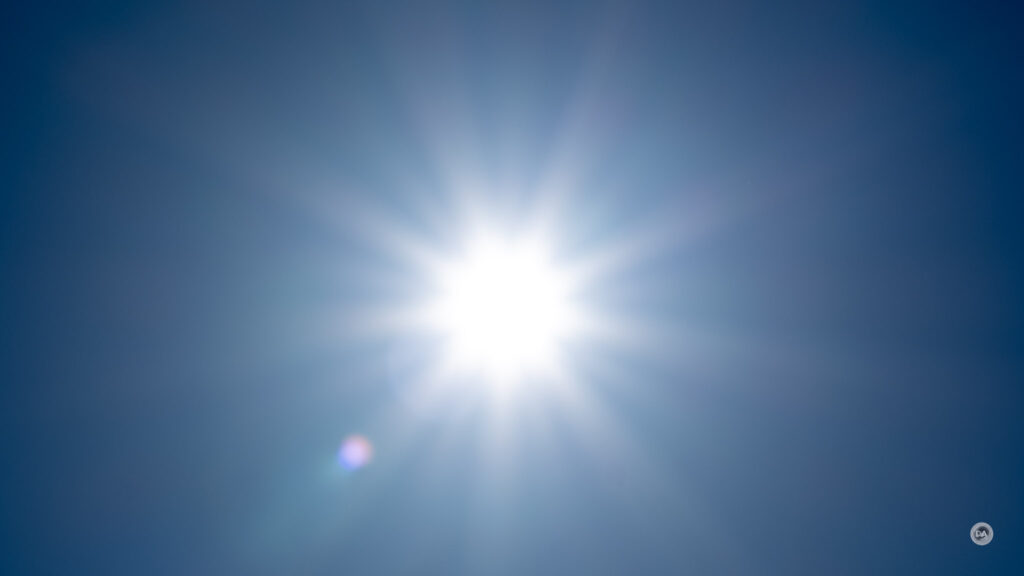
We have an important Viltrox standard in the form of a USB-C port on the metal lens mount that allows you to connect the lens to a computer and update the firmware directly. The firmware update process is very simple; just unzip the upgrade folder, drag the firmware update file to the folder that shows up when the lens is attached to the computer, and the update is done in seconds.
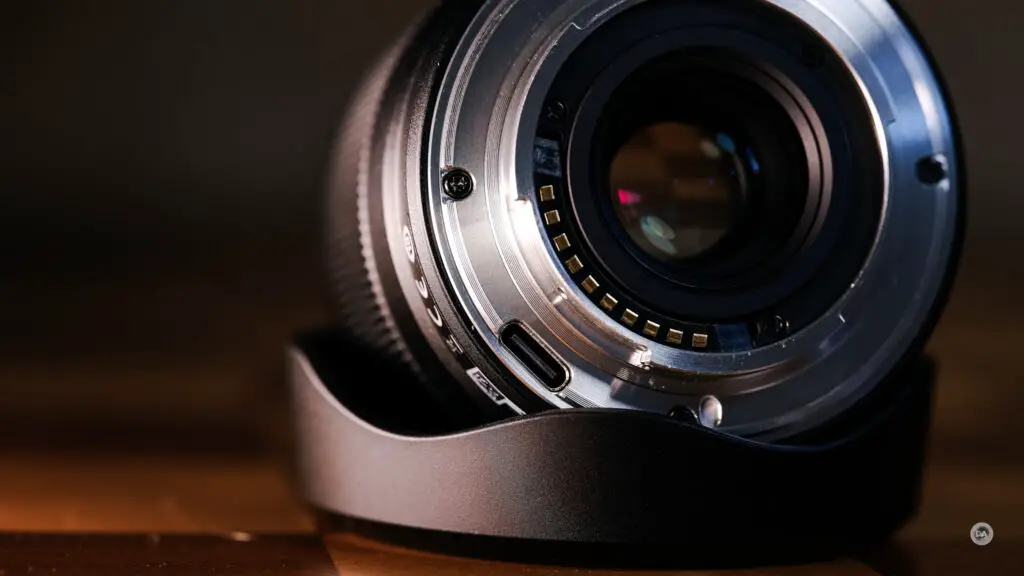
The Viltrox AF 56mm has a minimum focus distance of 55cm, which unfortunately isn’t particularly close and only produces a 0.11x magnification, which is a little lower than average for the class. Here’s what that looks like:

Fuji’s newest 56mm F1.2 WR and the Sigma 56mm F1.4 DN can focus as closely as 50cm and give a better 0.14x magnification, though the Viltrox AF 56mm F1.4 focuses only as closely as 60cm and produces a lower 0.10x, while the older Fujifilm XF 56mm F1.2 focuses only as closely as 70cm and produces an even lower 0.09x magnification. So if the new Viltrox AF 56mm F1.7’s magnification is low, it is not exceptionally so. You certainly won’t be able to do any “macro” work with it, but you can certainly get close enough to strongly blur out a background.
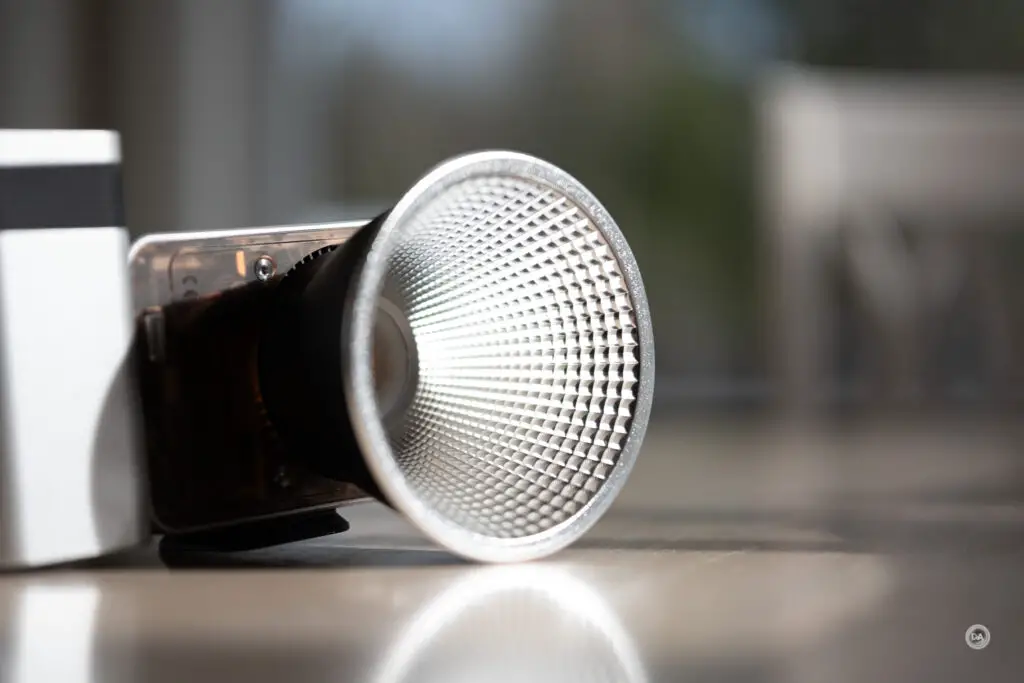
While some Viltrox lenses have started to come with weather sealing, this inexpensive 56mm lens does not have it. It does have a HD Nano multilayer coating with water-resistant and antifouling coating on the front element.

Though short on bells and whistles, the Viltrox AF 56mm F1.7 does excel in one key area: it is very compact and lightweight. And while there aren’t any special features, the lens feels sturdy and well made. As I noted in the intro, this is a lens designed for a specific market, and I feel like Viltrox has made the right choices in order to give us a functional lens that at the same time is extremely inexpensive.
Viltrox AF 57mm F1.7 STM Autofocus
The Viltrox AF 56mm F1.7 STM utilizes a lead-screw type stepping focus motor (STM) that makes for reasonably fast and definitely quiet focus changes. Focus felt silent unless I put my ear up next to the barrel, where I could hear some very light whirring during major focus changes. Focus speed is slightly below average, particularly indoors, though the lens sped up a bit outside. There are some obvious steps (howbeit rapid ones) from this particular stepping motor during significant focus changes. I noticed focus speed far less in normal work where it’s rare to go from close to distant all the time. More minor focus changes happen fast enough that it didn’t stand out.
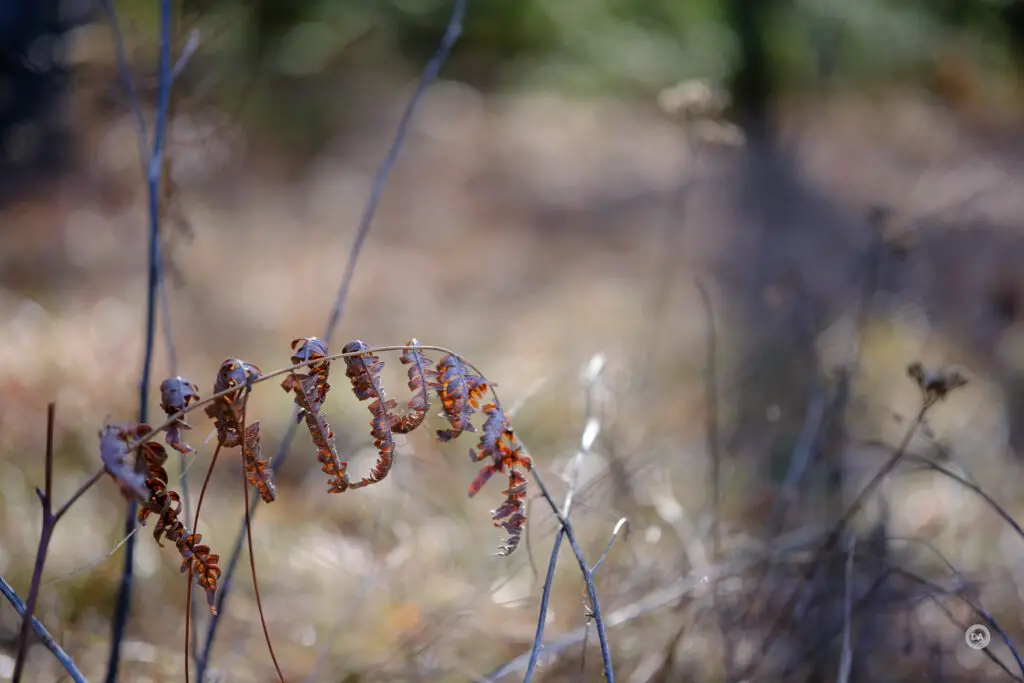
If focus speed is a bit disappointing (at least on Fuji), fortunately accuracy is not. I had good success locking onto a variety of subjects, up to and including portrait work. I shot two portrait sessions with the AF 56mm F1.7, and was very happy with my results from both. In the first session (primarily shot in a forest setting), I prioritized shooting through layers of boughs and branches to create natural frames for my subject, and autofocus had no problem locking accurately on what I wanted (the model’s eyes) rather than any of the distractions.

In the second setting, the setting was less complicated, but I did shoot at a number of focus distances and as my subject moved through a variety of different poses. Focus was excellent throughout the series.


I wouldn’t recommend the Viltrox AF 56mm F1.7 if your goal is shooting fast action, but for portrait work this lens is a HUGE bargain, delivering accurately focused results…and the lens optically is very, very nice:

This lens should be fine if you’re doing event, general purpose, or portrait work, but if you are looking for a lens fast enough to keep up with young children or animals moving around, look elsewhere.
Video AF is also a mixed bag. Focus pulls are rather unimpressive. They aren’t fast, and there is some obvious stepping in the process. This is very different from what I saw on Sony with the AF 20mm F2.8 lens, so at least part of this is the nature of Fuji’s video AF, which is a fair bit behind what I see on Sony and Canon. I was also testing the new Fuji XF 56mm F1.2 WR, and focus pulls, if anything, were worse.
My hand test was also a mixed bag, as while transitions from my hand to my eye and back were smoother and more confident, the slow reaction time meant that at least one of those transitions was missed altogether because the transition had already passed.
But ironically this was a positive for some real world shots where I moved slowly from one subject to another. Rather than an abrupt transitions, the focus transitions were actually fairly cinematic, moving smoothly and gradually from one subject to another. This is helped by focus breathing being fairly low for this long of a focal length, so this also helps keep you “in the shot”. Here’s a still from one of those transitions.
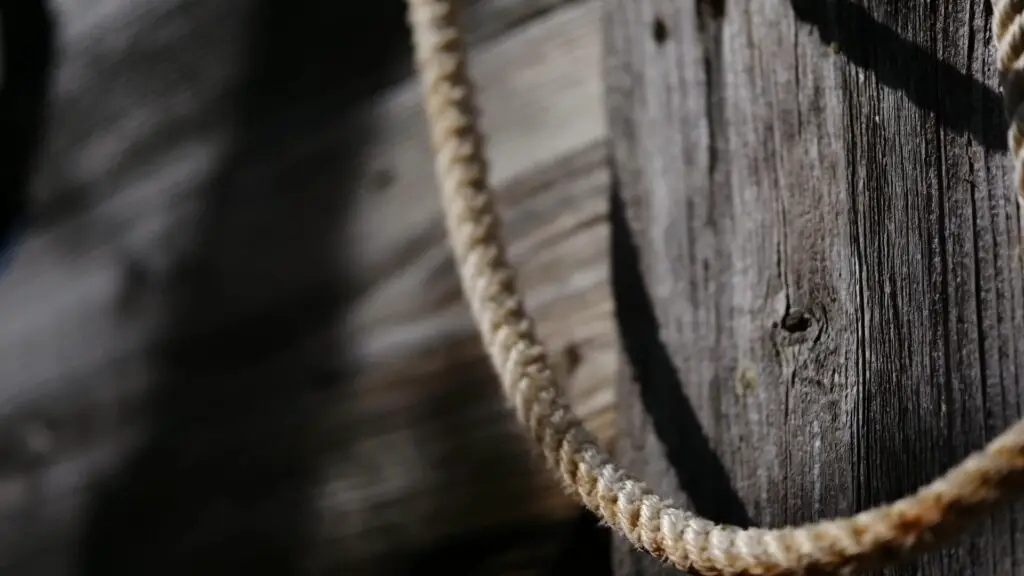
So, as with stills, choose this lens for accuracy over speed. There are faster options for focus speed at this focal length, but for slower work it will get the job done, and I suspect that future versions for other mounts will probably sport a little more speed.
Viltrox AF 57mm F1.7 Image Quality
The Viltrox AF 56mm F1.7 has an optical design of 11 elements in nine groups. What’s surprising in such an inexpensive lens is how many of these are exotic elements. There are four ED (extra-low dispersion) elements along with an additional 3 HR (high refractive index) elements, leaving just four of those elements being ordinary ones. We’ve previously noted how good the MTF chart for this bargain lens looks:
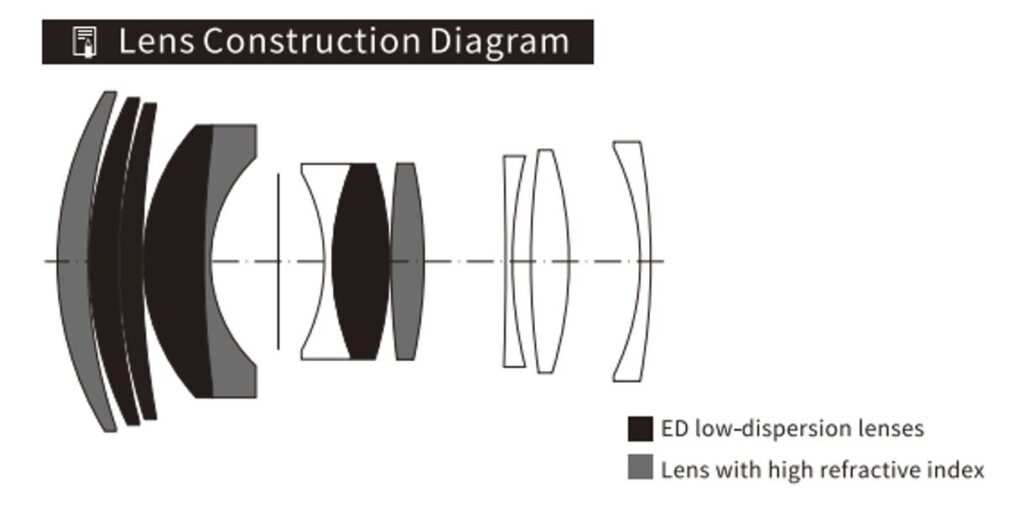

All of this adds up to a lens that is punching above its weight class optically, which is important, as the 40MP Fujifilm X-H2 is the most demanding sensor for lens performance of any platform that I test.

We’ll work through the chart results by first looking at distortion and vignette. The lens clears this hurdle largely unscathed, as there is minimal distortion, and, while vignette is a bit heavier, it isn’t extreme.

I used a-3 to correct a tiny bit of pincushion distortion, though for portrait work you probably don’t want to correct that (a bit of pincushion distortion is flattering). Vignette required a +75 to correct (3 stops), though it is fairly linear and largely “works” for portraits, creating a natural vignette that draws the eye to the subject. You can see in this comparison that the left side is profile corrected and the right is uncorrected. I personally favor the uncorrected result.
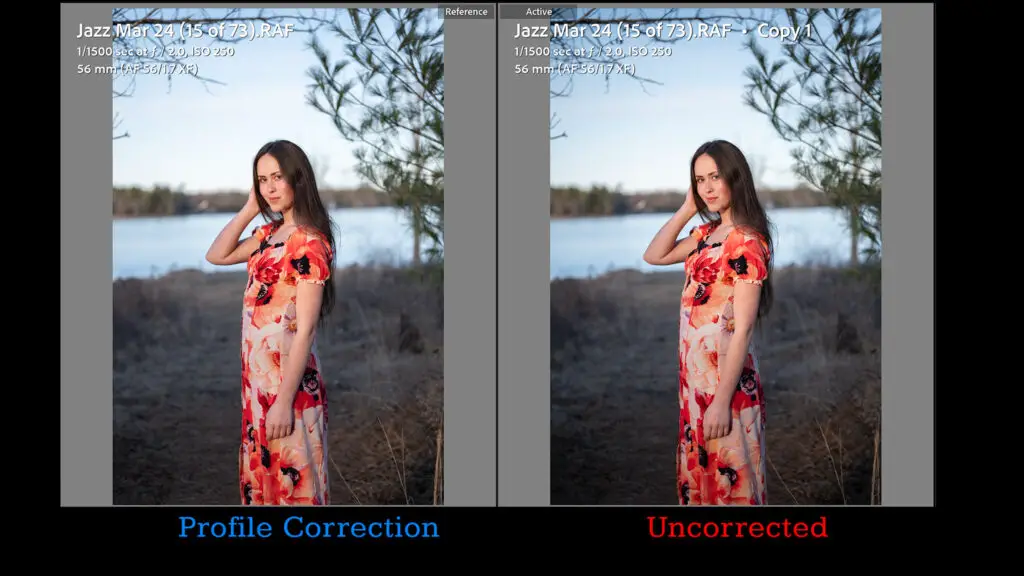
I sort images to my two card slots in my camera, with RAW files going to a CFExpress Type B card and JPEGs going to the SD card. This allows me to have both a backup and a frame of reference in situations like this, as I was curious as to whether or not this Viltrox lens is getting in-camera corrections on Fuji. The answer seems to be “yes”, with the JPEG showing far less vignette than the uncorrected RAW file.
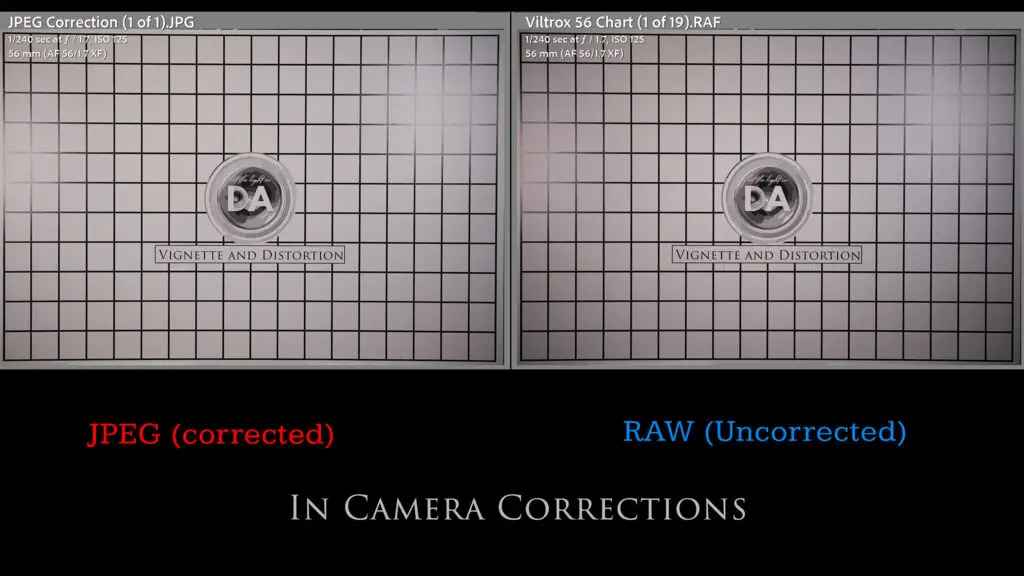
There is a RAW correction profile available, and while I think it leaves a bit more vignette than what I would like, it largely matches the look of the JPEG image above.
The 56mm F1.7 shows very low amounts of longitudinal chromatic aberrations. Fringing is well corrected, leaving very little fringing on either my test results:
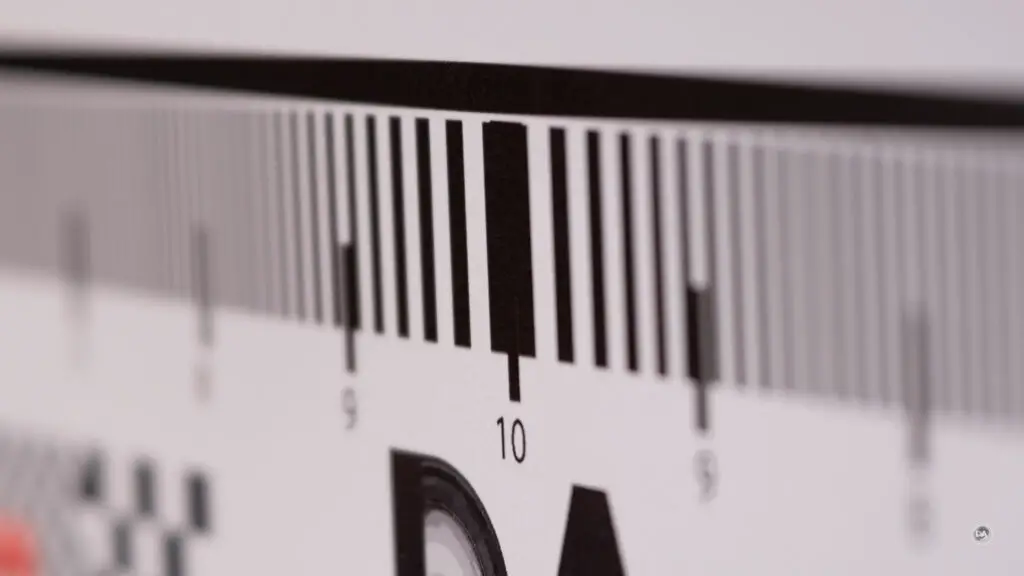
…but more importantly on real world results. Look at how neutral the inside and edge of this very shiny light reflector is – next to no fringing.
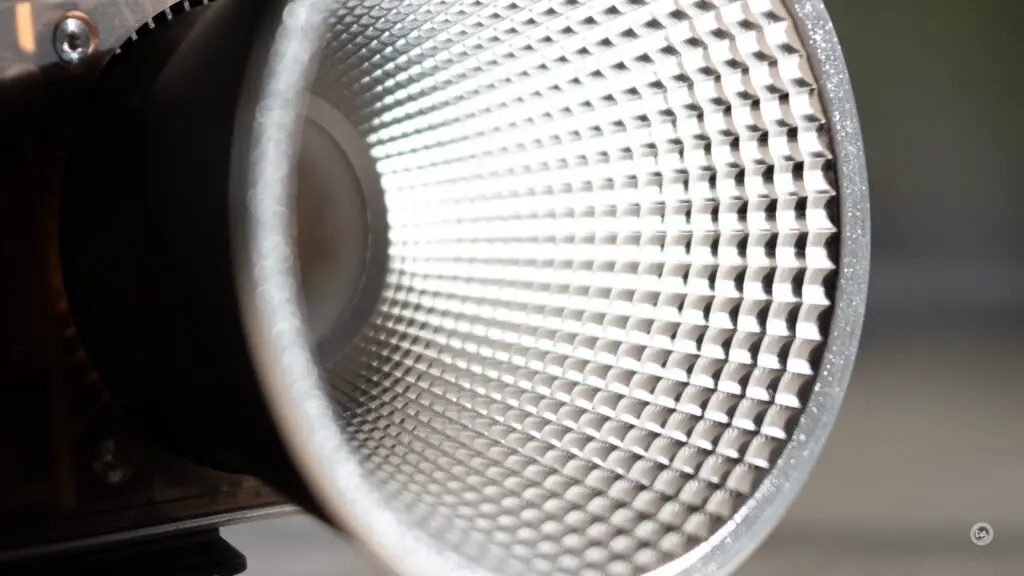
Lateral Chromatic Aberrations usually show up along the edges of the frame as fringing on either side of high contrast areas (like bare branches framed at the edge of images), but that doesn’t seem to be an issue here. You can see a nice, neutral transition from black to white on the corners of my test chart.

I also didn’t spot any issues in real world results, and my high resolution X-H2 would certainly show them off if they were there!
So how about resolution and contrast? All chart tests done with a Fujifilm X-H2 (40MP) using a tripod and a two second timer. Here’s a look at my test chart:

And here are the crops (at roughly 170% magnification) from the center, mid-frame, and extreme corner at F1.7:



We see here what the MTF chart suggested. Peak sharpness is actually slightly off center (more in our mid-frame image – the blue bill), while corner results are unusually good for this type of lens. This is a remarkably even performance in a way that I rarely see in lenses and almost never in budget lenses. To put that edge performance in perspective, here’s a look at the Sirui Sniper 56mm F1.2 stopped down to F1.8:

A more similarly priced lens is the soon-to-be-released TTArtisan AF 56mm F1.8, and while the TTArtisan lens is competitive in the center of frame, the Viltrox AF 56mm F1.7 is much sharper in the mid-frame and corners. Here’s a look at the mid-frame comparison:
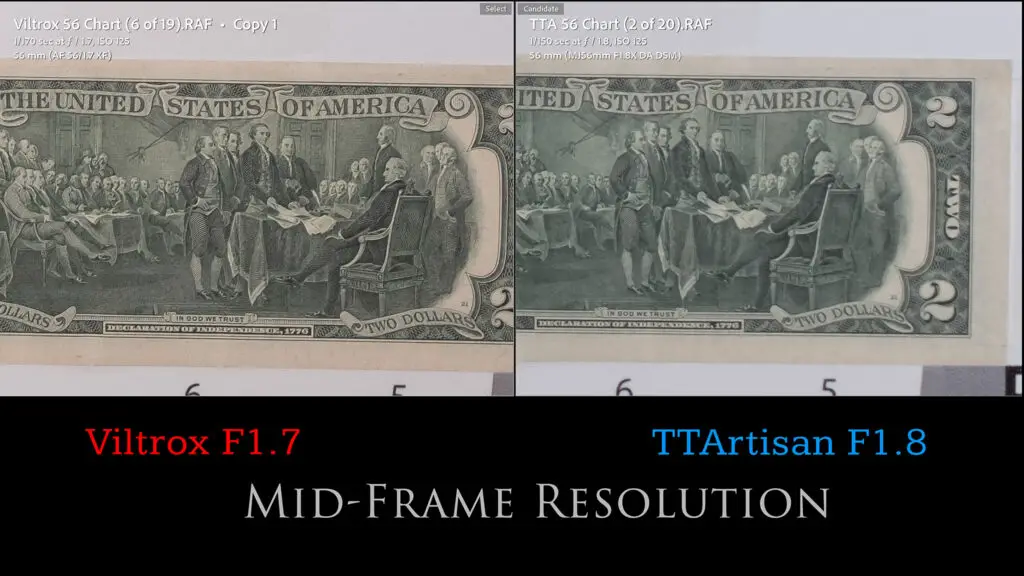
In real world images wide open contrast isn’t flawless in the way a lens like the Viltrox Pro AF 75mm F1.2 is, at least on Fuji’s 40MP APS-C sensor, but I suspect it would be on 26MP sensors from Fuji or Sony. Even on 40MP, however, results look great:


This becomes the new champ for the least expensive way to take full advantage of resolving this taxing sensor and will leave most of Fuji’s older lens catalog in the dust (including the older XF 56mm F1.2). The new Fujifilm XF 56mm F1.2 WR is sharper and higher contrast in the center of the frame (at F1.8), but the Viltrox actually has the slight edge in the mid-frame and corners. It’s a very impressive lens.
The Viltrox clearly can’t compare to the Fuji in build, features, and autofocus speed (not to mention it doesn’t have F1.2), but when both lenses are stopped down a bit to F2, it is shocking how comparable they are for portrait work in both overall rendering and color…

…and also for contrast, detail, and skin tones.

This is probably the most impressive budget portrait lens on Fuji X-mount.
In my chart tests, I saw little advantage in stopping down a bit, but in real world results I did feel that contrast improved, allowing the details to pop a bit more:
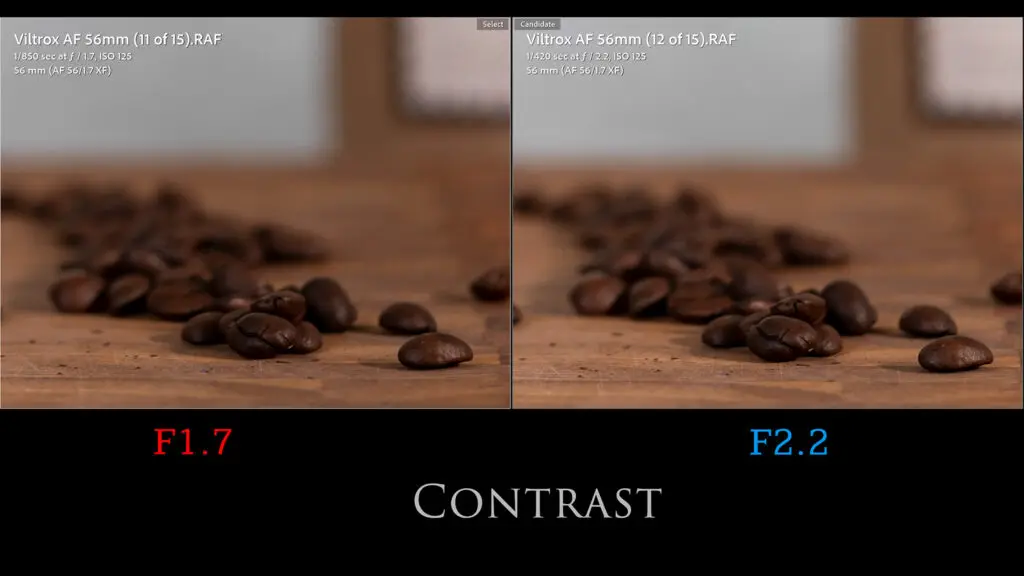
While the difference isn’t obvious, I did prefer shooting at F2 to F1.7 for portrait work as I felt there was more variation in the highlights and shadows on my subject’s faces due to that slight improvement in contrast.
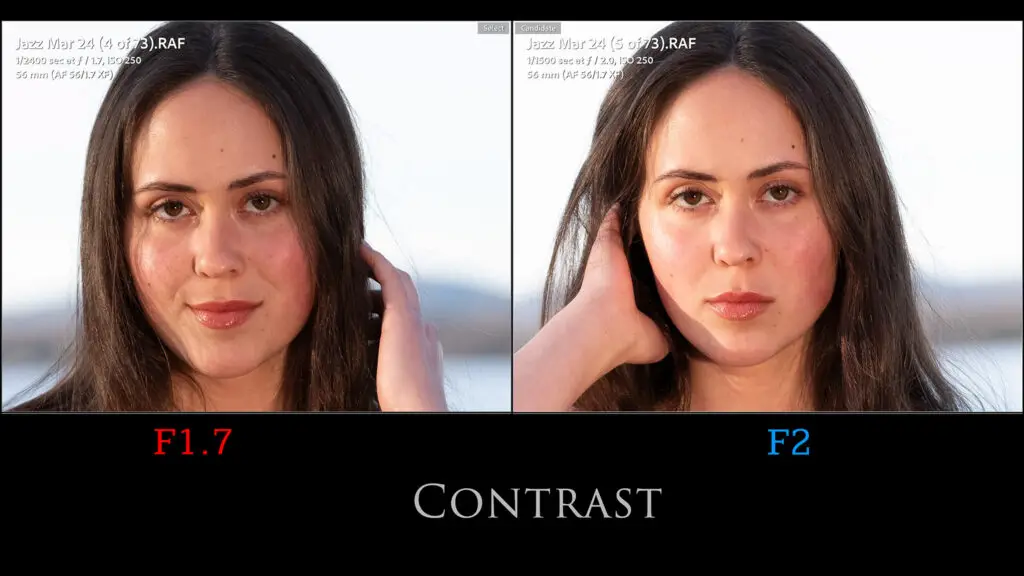
Centering wasn’t perfect on my copy, with the results on the left side of the frame being slightly softer than the right side. Sharpness on the left side picked up as I stopped the lens down, with peak consistency across the frame coming at F5.6. By this point I found landscape images were sharp across the frame (my second crop is from the left side):


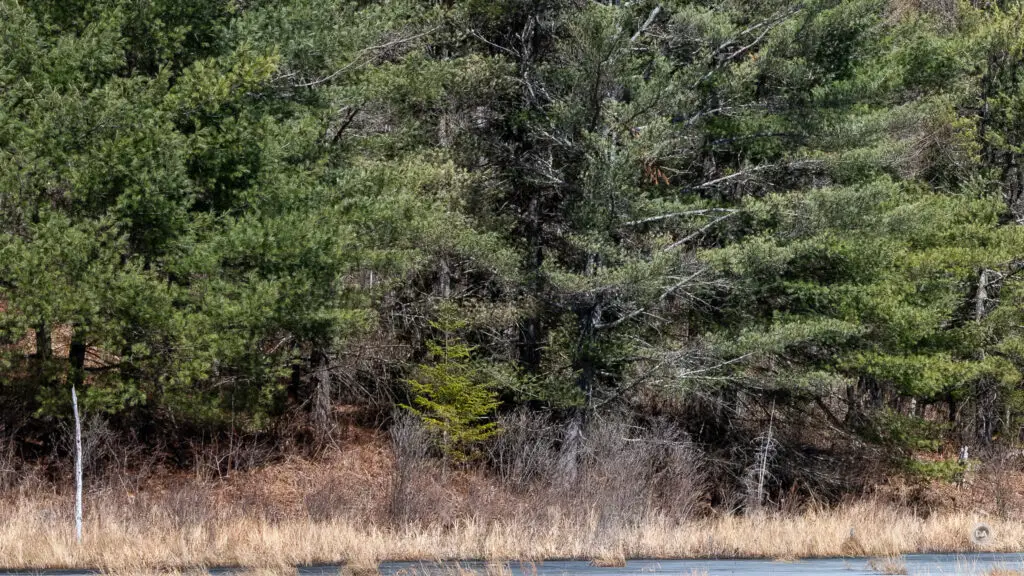
On a high resolution body like my X-H2, diffraction comes early, so while F8 still looks as good as F5.6, by F11 you will see some softening of the fine details due to diffraction, and by F16 (minimum aperture) the image is considerably softer.
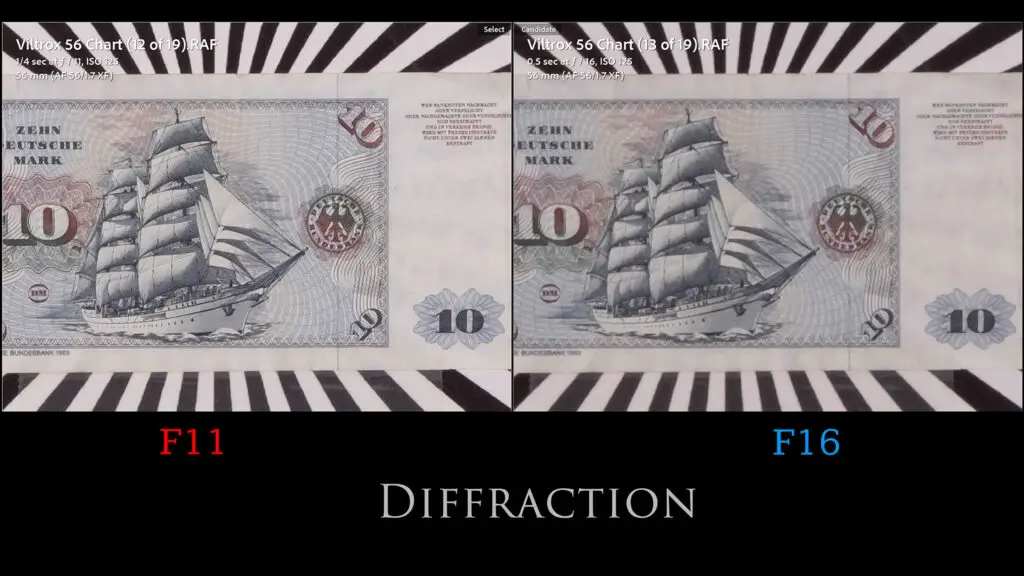
Obviously the amount of sharpness this inexpensive lens is capable of is nothing short of impressive.
I was also fairly pleased with the quality of bokeh. On the negative front, you can see that there is some of the typical deformation of the circular shape of specular highlights near the edges of the frame (lemon shape):
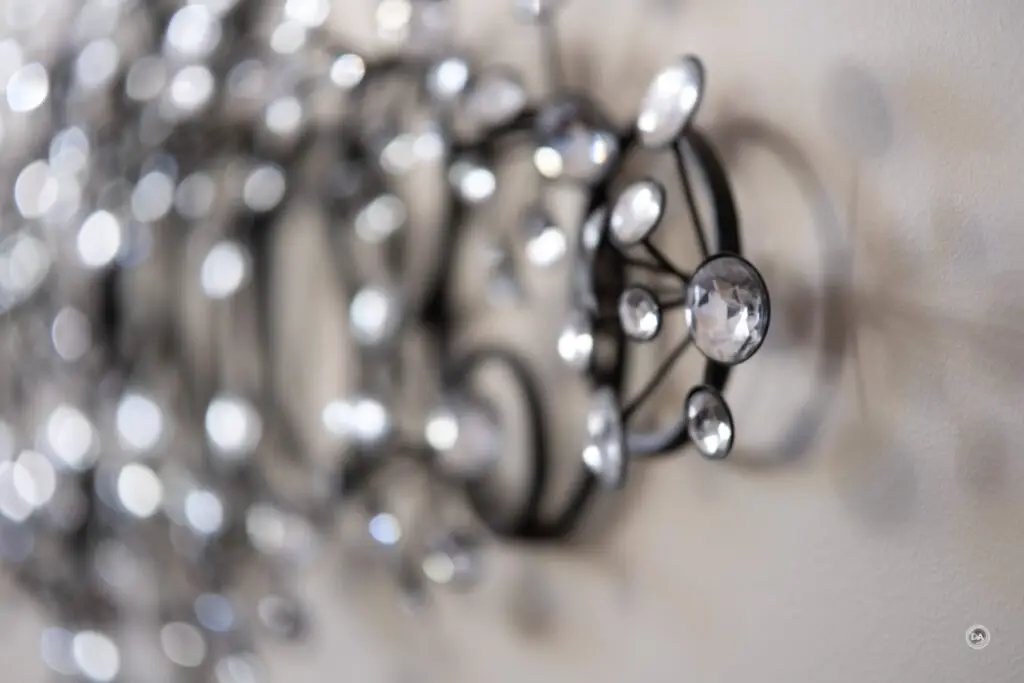
But that does produce a bit of a “swirl” effect at F1.7 than some people are partial to:

I found that bokeh at portrait distances was generally favorable – soft and without any hard edges to grab the attention.

The subject isolation isn’t going to match an F1.2 or F1.4 lens, obviously, but the quality of the blur is nice.
To give you some perspective, here’s another comparison to the Fuji XF 56mm F1.2 WR with both lenses wide open. At a casual glance, the difference is not astranomical.
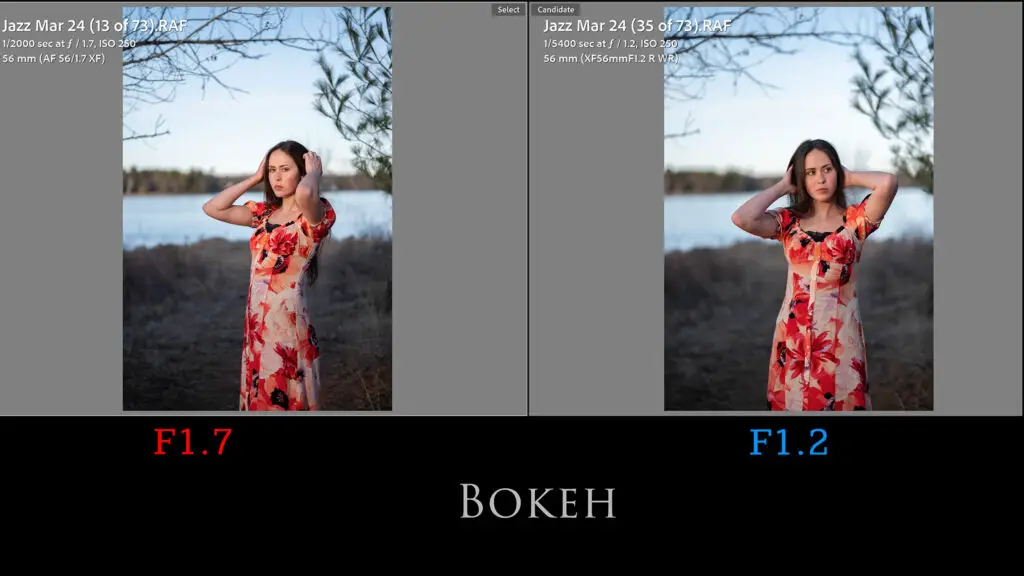
But if you look closer, the quality and softness of the blur out of the out-of-focus areas is significantly different.

The result on the right is what you pay the big bucks for, and that difference is going to be even more pronounced in less favorable situations where the background is closer.
At close focus distances, the Viltrox AF 56mm F1.7 produces lovely, blurred backgrounds, like in this shot of its attractive competitor – the TTArtisan AF 56mm F1.8:
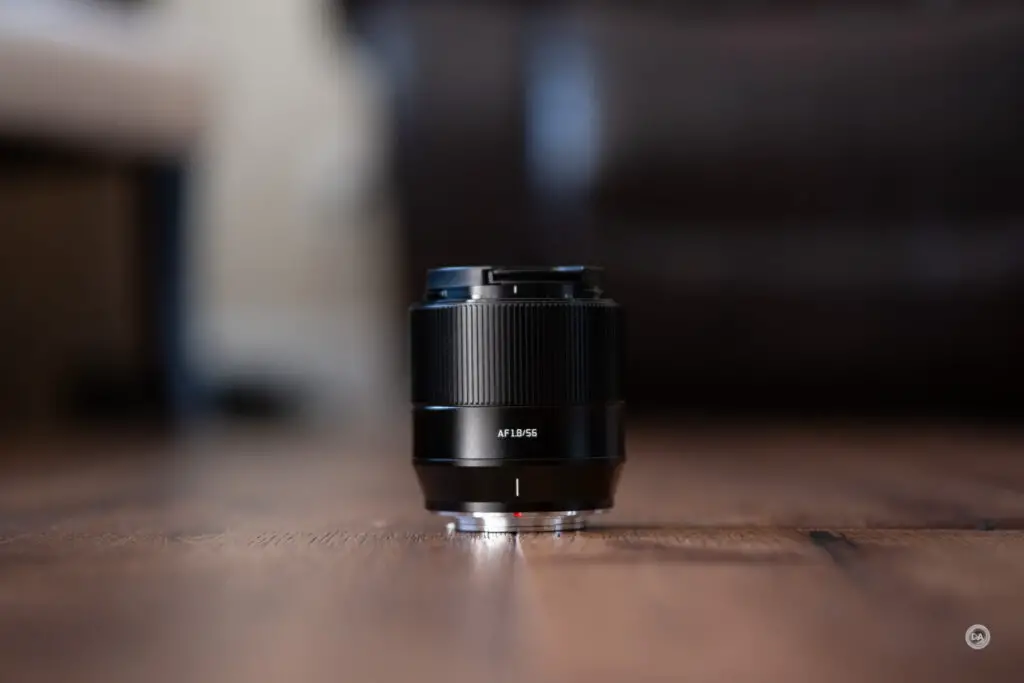
What really surprised me in the comparisons with the very expensive Fuji XF 56mm F1.2 WR is how similar the colors looked. I’ve been working on my review of that lens, and I love the color and look of images from it. I traveled to Myrtle Beach with it along with three standard zoom options (Sigma 18-50mm F2.8, Fuji 18-55mm F2.8-4, and the Fuji 16-55mm F2.8). There’s no question that the images from the 56mm F1.2 had an extra “sparkle” to them that I instinctively preferred. The Viltrox is almost certainly not as good as the Fuji, but in my side by side portrait sessions I was surprised by how well the Viltrox held up.
That’s huge, as my chief objection to early Viltrox lenses is that I didn’t love the colors from their optical glass. They have grown so much as a lensmaker, and it is apparent even in these budget lenses.

Flare resistance was also fairly good for a short telephoto lens. I saw so mild ghosting artifacts when point right at the sun, but nothing significant. I also tried moving around to get some veiling at large apertures, and the final result is the worst result I could get…and it’s not bad!

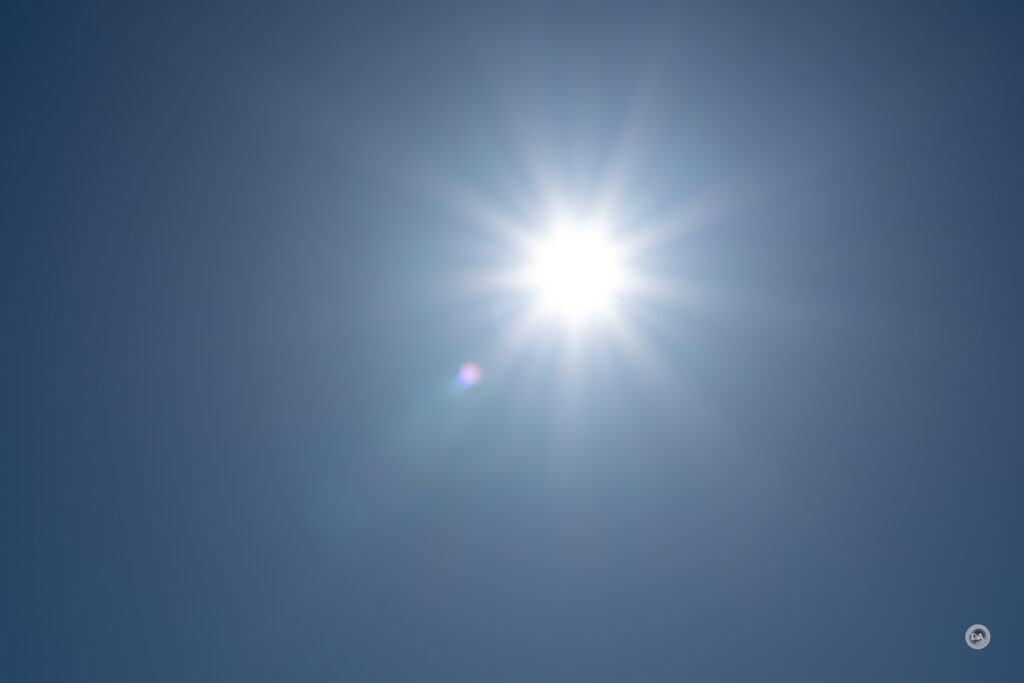

This inexpensive lens houses some very impressive optics. There aren’t too many flaws here.

If you’re on a tight budget and want a portrait lens, look no further. The bang for the buck here is fantastic. This lens feels as compelling as many lenses that I’ve reviewed costing 2-3 times as much. You can see more beautiful images by visiting the image gallery here.
Conclusion
I’ve been surprised by how engaging I have found these budget Viltrox lenses. I love their new higher end lenses with the amazing optics and premium feature set, but there’s also a lot to be said for lightweight, inexpensive lenses that exceed your expectations for their performance. These lenses have tapped into the same fondness I feel for lenses like Samyang’s Tiny series in that there is always a bit more than meets the eye there.

While I’ve reviewed the Viltrox AF 56mm F1.7 STM on one of Fuji’s largest bodies, this is a lens that will be a great match for Fuji’s smaller bodies, particularly those equipped with IBIS (like X-S10 or X-S20). It will have no problem resolving that smaller 26MP sensor and delivering stunning results.

Because I had a clear idea of what to expect in the build, I have no disappointments there. While there’s nothing fancy here, the lens feels tough and well made. The optics exceeded my expectations in just about every way, leaving only the autofocus as being a bit less than expected. Some of that clearly has to do with this being a Fuji X-mount lens, as Fuji’s autofocus just isn’t as sophisticated as some competitors. I hope to revisit a Sony E-mount version of the lens when released, as I suspect that will be more impressive. But this is a LOT of lens for the price of under $150 USD, and I think this is a great budget portrait option for Fuji shooters who don’t want to spend a lot. It’s also the lowest priced lens I’ve yet tested that really thrived on Fuji’s demanding 40MP sensor. That’s impressive, and is just one more reason why Viltrox as a brand may be the biggest disrupter that the lens market has seen in a long time.
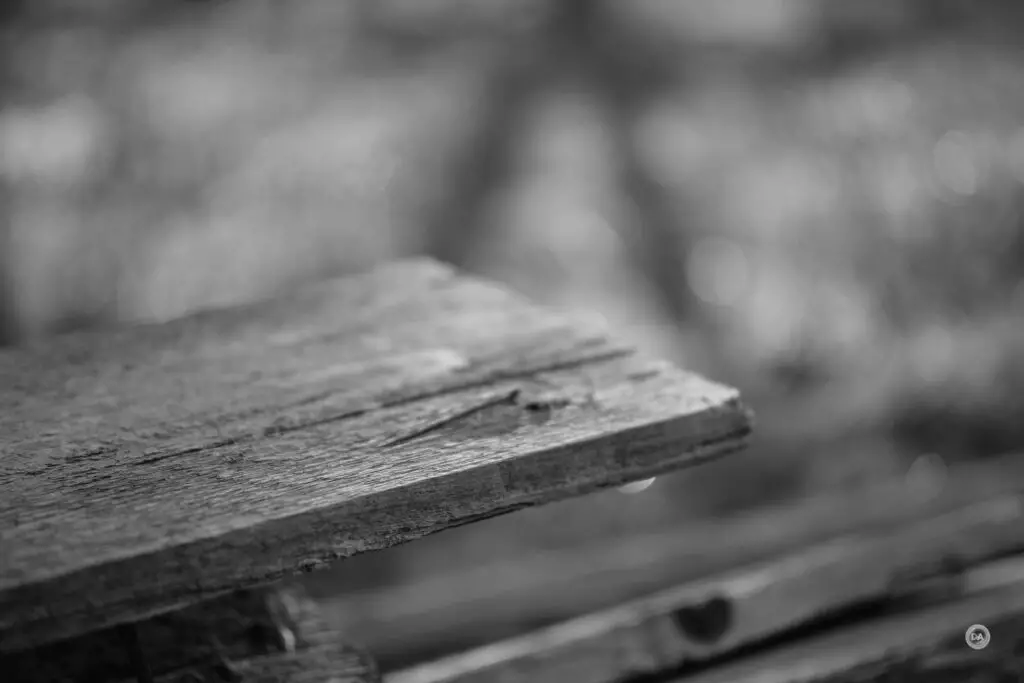
Pros:
- Lightweight, compact design
- Lens feels tough and well made
- Well executed, smooth manual focus ring
- USB-C port for firmware updates
- Good focus accuracy
- Cinematic focus transitions for video
- Outstanding sharpness from F1.7 on
- Very nice bokeh
- Fairly low distortion
- Good color rendering
- Fantastic price to performance ratio
Cons:
- Autofocus a bit slow
- Some visible steps from focus motor
- Vignette a bit heavy
- No weather sealing or features
__________________________________________________________________________________________________
GEAR USED:
Purchase the Viltrox AF 56mm F1.7 @ Viltrox (use code DUSTINABBOTT for 8% off starting April 23rd) | B&H Photo | Adorama | Nuzira | Amazon | Amazon Canada | Amazon UK | Amazon Germany
——————————————————————–
Purchase the Fujifilm X-H2 @ B&H Photo | Adorama | Amazon | Camera Canada | Amazon Canada | Amazon UK | Amazon Germany
Purchase the Fujifilm X-T5 @ B&H Photo | Amazon | Camera Canada | Amazon Canada | Amazon UK | Find it Used at KEH
Purchase the Fujifilm X-S20 @ B&H Photo | Adorama | Amazon | Camera Canada | Amazon Canada | Amazon UK | Amazon Germany | Ebay
Want to support this channel? Use these affiliate links to shop at: B&H Photo | Amazon | Adorama | Camera Canada | Amazon Canada | Amazon UK | Ebay | Make a donation via Paypal
Buy DA Merchandise https://bit.ly/TWIMerch
Keywords: Viltrox, Viltrox AF, Viltrox 56mm, Viltrox 56mm F1.7, 56mm, F1.7, STM, AF, Fuji X-H2, Fujifilm, Fuji X-T5, X-S20, Full Frame, Review, Review, Hands On, Dustin Abbott, Real World, Comparison, Sharpness, Bokeh, Flare Resistance, Autofocus, Image Quality, Sample Images, Video, Portrait, #viltrox, #letthelightin, #viltroxAF1756, #DA
DISCLAIMER: This article and description contains affiliate links, which means that if you click on one of the product links, I’ll receive a small commission. As an Amazon Associate I earn from qualifying purchases.










 Nikkor Z 35mm F1.2 S Review
Nikkor Z 35mm F1.2 S Review  Kase AF 85mm F1.4 Review
Kase AF 85mm F1.4 Review  Fujifilm X-Half Review
Fujifilm X-Half Review  Nikkor Z 35mm F1.8 S Gallery
Nikkor Z 35mm F1.8 S Gallery 


